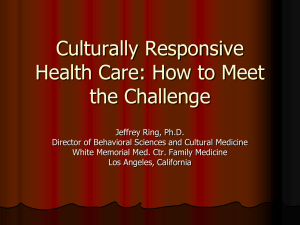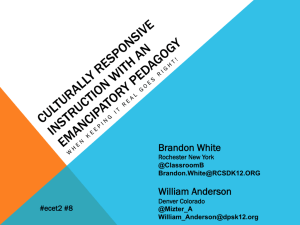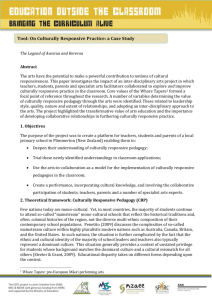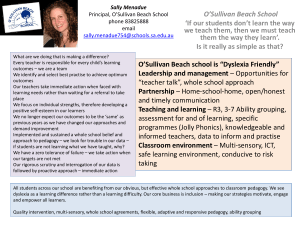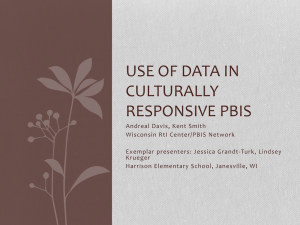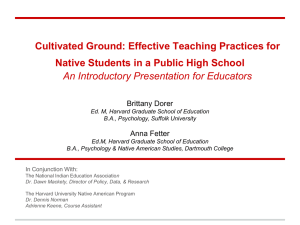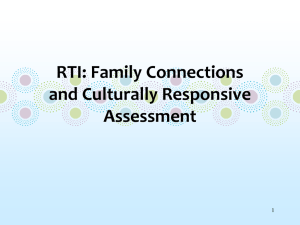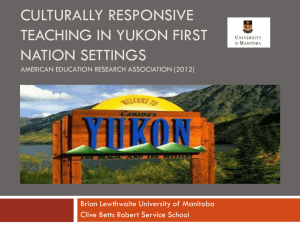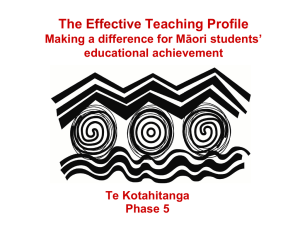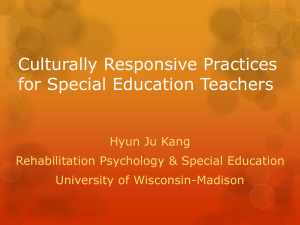Culture Counts 1 - Much Ado About English
advertisement
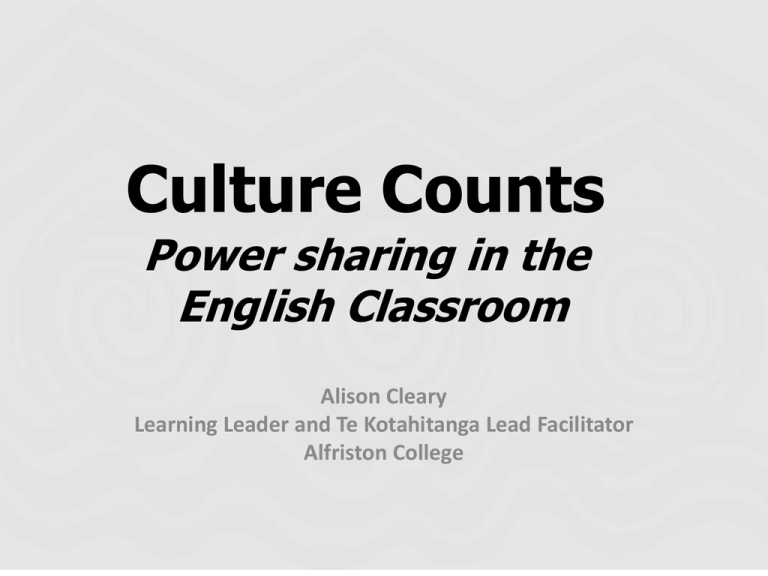
Culture Counts Power sharing in the English Classroom Alison Cleary Learning Leader and Te Kotahitanga Lead Facilitator Alfriston College Learning intention: • To increase our understanding of the term ‘culturally responsive pedagogy of relations’ • To determine what a CRP of R could look like in an English classroom. • To reflect on our own practice in terms of CRP of R. Success criteria: I can: I have: I A Te Kotahitanga facilitator’s ‘core business’ is to support teachers to develop an understanding of and the ability to create a culturally responsive pedagogy of relations (CRP of R) in their classrooms in order to improve outcomes for Māori students. But what exactly is meant by the term a culturally responsive pedagogy of relations? Culturally responsive pedagogy 239,000 hits in 39 secs Culturally responsive pedagogy of relations 49,000 hits in 39 secs R.Bishop, M.Berryman, T.Cavanagh and L.Teddy (2007) A culturally responsive pedagogy of relations is one where teachers: create learning contexts that will address the learning engagement and improve the achievement of Māori students by developing learning - teaching relationships where the following notions are paramount. Where power is shared: • where learners can initiate interactions; learners’ right to self-determination over learning styles and sense making processes are regarded as fundamental to power-sharing relationships, and collaborative critical reflection is part of an ongoing critique of power relationships; Where culture counts: • where classrooms are places where learners can bring “who they are” to the learning interactions in complete safety, and their knowledge’s are ‘acceptable’ and ‘legitimate’; Where learning is interactive and dialogic: • learners are able to be co-inquirers; learning is active, problem-based, integrated and holistic; learning positionings are reciprocal (ako) and knowledge is co-created; classrooms are places where young people’s sensemaking processes and knowledge’s are validated and developed in collaboration with others; Where connectedness is fundamental to relations: • teachers are committed to and inextricably connected to their students and the community; school and home/parental aspirations are complementary. Where there is a common vision: • an agenda for excellence for Māori in education Where power is shared between selfdetermining individuals within nondominating relations of interdependence; where culture counts; learning is interactive, dialogic and spirals; participants are connected and committed to one another through the establishment of a common vision for what constitutes excellence in educational outcomes. (Bishop et al, p.25) What might this mean for • The classroom teacher? • An HOD/HOL? What questions might we ask around our own practice? As a classroom teacher… • Does your classroom look like a place where the students are valued for who they are? • Is current student work displayed? • Do you change what’s on your walls regularly or has it become ‘wallpaper’? • Would a visitor to your room know that they were in an English classroom in New Zealand and not just an English classroom anywhere in the world? • Is the classroom a space your students feel comfortable in and experience a sense of belonging? Building learning relationships (Know the learners) • • • • • Data Details Goals and aspirations Formative assessment tasks Student voice and feeback Programmes of learning • • • • • • Booking systems Interest vs availability Student voice Change change change Tried and trued vs brave and new Resources vs change Co Construction and Collaboration • • • • • Prior knowledge Inquiry based Choice Self determining Differentiation – programme, content, assessment Co Construction and Collaboration • • • • • • Learning intentions Success criteria Co-operative learning Tuakana/Teina 1-1 at their desks Ako Culturally appropriate contexts • Do you ever include whakatauki* in your language activities or make clear links between Te Reo and English? • Do you use Te Reo in your classroom for any instructional verbs? Or for praise? • Do you ever make connections between the traditional stories of Shakespeare and Māori oral history – for example Romeo and Juliet compared to Tutanekai and Hinemoa? • Is your word of the week ever in Te Reo? Jane's story Jane’s Story As an HOD/HOL….. • As an HOD do you allow your staff the flexibility to adapt the themes or units of study to meet the needs of their learners? • Do you actively plan to include texts that reflect the cultural worlds of the learners in your programmes? • Do you meet with other learning area HODs to find opportunities to make cross-curricular links between them and your English programme – especially in the junior school? • Do your common assessment tasks provide choice and are they multi-levelled? Links to the NZC Learning is inseparable from its social and cultural context. Students learn best when they feel accepted, when they enjoy positive relationships with their fellow students and teachers, and when they are able to be active, visible members of the learning community……… Students learn best when they are able to integrate new learning with what they already understand. Teachers can help students to make connections across learning areas as well as to home practices and the wider world. Effective teachers attend to the cultural and linguistic diversity of all their students. The classroom culture exists within and alongside many other cultures, including the cultures of the wider school and the local community, the students’ peer culture, and the teacher’s professional culture. (NZC pg 34&35) Links to Ka hikitia (Managing for Success: Maori Education Strategy 2008 – 2012) The concept of ako describes a teaching and learning relationship, where the educator is also learning from the student and where educators’ practices are informed by the latest research and are both deliberate and reflective. Ako is grounded in the principle of reciprocity and also recognises that the learner and whänau cannot be separated. Culture and education are inextricably interwoven, in the education system as well as in the learning setting. Mäori children and students are more likely to achieve when they see themselves, their whänau, hapü and iwi reflected in the teaching content and environment, and are able to be ‘Mäori’ in all learning contexts. (Ka Hikitia, p20) JGeek – Maori Boy JGeek and the Geeks - I'm a Maori boy Student Responses This song was offensive because its not al things Maori people do. They didn’t wear loin clothes when they first came to NZ and they don’t have the same tattoos as Aboriginals – they have koru patterns and they were green and not blue. They should have made a song about being a geek and not being a Maori. I think it was a project that university students had to do probably for a film study project. Student responses The style of this video was almost parody like, with characters dressed in nothing but loin clothes half the time… I found the costumes quite odd as although they were trying to portray a traditional Maori theme, with the fake Maori tattoos, they did not match as Maori did not wear loin cloths… ….I think the video is made in good fun… Student voices Student voices Further readings or viewings for those interested in developing more of an understanding or knowledge of this topic. http://edtalks.org/play.php?vid=279 Russell Bishop – A culturally responsive pedagogy of relations. Christchurch, Core Education Ltd. http://edlinked.soe.waikato.ac.nz/departments/index.php?dept_id=20 Te Kotahitanga Research Unit Bishop, R., O’Sullivan, D., and Berryman, M. (2010). Scaling up Education Reform: Addressing the Politics of Disparity. NZCER Press, Wellington. Bishop, R., Berryman, M., Cavanagh, T. and Teddy, L. (2007). Te Kōtahitanga Phase 3: Establishing a Culturally Responsive Pedagogy of Relations in Mainstream Secondary School Classrooms. Learning Media, Wellington. Ministry of Education. (2007). New Zealand Curriculum. Learning Media, Wellington. Ministry of Education. (2008). Ka Hikitia (Managing for Success: Maori Education Strategy 2008 – 2012). Wellington. Montgomery, W (2001). Creating culturally responsive, inclusive classrooms. TEACHING Exceptional Children, Vol. 33, No. 4, pp. 4-9.
